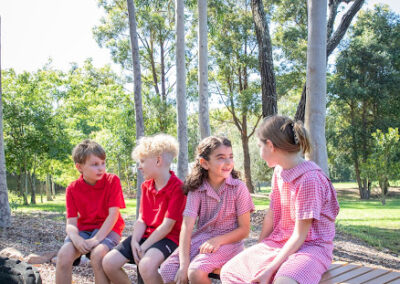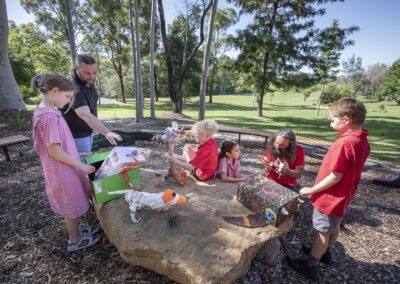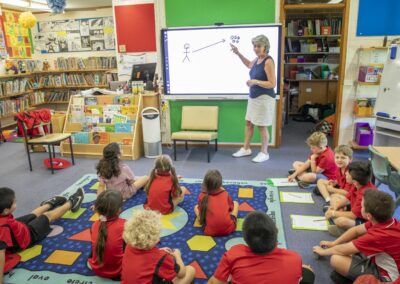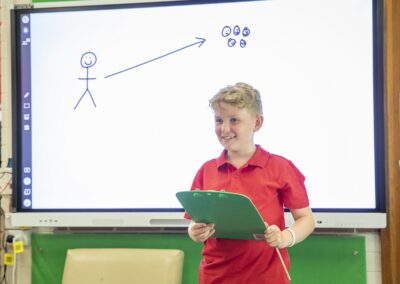LEARNING ACTIVITY
STORY
Adam was coming in to the school to work with Jarrah and his friends in the bush tucker garden and see what else they could do to enhance the space. He noticed that both Jarrah and Ricky were in a bit of a silly mood and not focussed on the task at hand.
Adam decided to change things up and create a yarning circle.
Adam began, “Ok guys, let’s take a break and have a seat in the circle. Let’s grab the talking stick that Uncle Paul gifted us so we know when it is our turn to speak. I want to ask you all about the next steps for our garden and what we would like to see added to the area. I have asked Mrs Smith to sit with us too and listen to your ideas so he can understand how to move the project along. Here is the talking stick, Jarrah. You can speak first.”
As the stick was passed to Jarrah he thought for a moment and then said, “I would like to see some more artwork in here. Can we design some art on the brick wall behind the garden?”
“That is a great idea,” said Adam. “Ok, can you pass the talking stick to Ricky now? Ricky what would you like to see in the garden space?”
“I think we need a good place to sit; maybe some logs or something,” he suggested. “Oh, and I also want more Midyim berries!”
The whole class laughed as they knew how much Ricky loved his berries.
“That sounds good,” said Adam. “But we better hear from Mrs Smith now too. Would you like a turn to add any thoughts?”
“Thank you, they all sound like great ideas!” said Mrs Smith. “I was thinking we could do a fundraising event with the school to raise some money for a First Nations artist to come help paint a mural on the wall. Oh, and to purchase some more Midyim berries too!” he said, smiling.

This activity is the seventh activity in an 8-part activity sequence that has been developed to help you design, build and use a yarning circle in your space.
This activity is designed to help make sure your yarning circle is used often, as well as to make links to First Nations people’s understanding of local seasons.
The order of these learning activities are: background, site selection, involving First Nations people, building the yarning circle, connecting to Landcare, using the yarning circle, yarning circle activities and yarning and wellbeing.
For children to:
- develop a calendar for the yarning circle
- be empowered to utilise the space
- incorporate First Nations weather knowledge and understanding of seasonal change.
This activity can be undertaken at any time of the year.
Introduction
There are many different activities that can take place in your yarning circle. Yarning circles provide opportunities for all to be heard, for discussions to be had and for understandings to be reached.
This series has been created to help ensure your yarning circle is used regularly; and is a space that staff and students alike want to return to again and again and can be incorporated into existing activities or to inspire new ones.
The planner created in this Learning Activity should be displayed in a central location, such as the staff room or main entry, to remind teachers about the yarning circle and the various things that can take place there.
This activity also draws upon the Local Seasons: exploring First Nations weather knowledge Learning Activity in the Learning Centre.
* This is dependent on having already completed the Local Seasons: exploring First Nations weather knowledge Learning Activity, and pre-work such as a list of activities and dates compiled.
Checklist
Instructions

Step 1
Introduction:
Begin this activity with an Acknowledgement of Country. By acknowledging the Land, you are also making a promise that you will recognise the cultural practices of First Nations people.
Explain to your students that today you are going to create a calendar for the yarning circle. This is to help everyone know what the circle can be used for, when it will be in use and to remind everyone that it is there to be used.
Head outside to the yarning circle.
Review the local seasonal knowledge for your area using the Local Seasons: exploring First Nations weather knowledge Learning Activity.

Step 2
Activity allocation:
Working in pairs or small groups, assign students ownership of an activity that could occur in around the yarning circle, such as:
- Junior School Council meetings
- Morning circles
- Yarns around important events in the calendar, for example, NAIDOC Week, Reconciliation Week, National Sorry Day, Mabo Day and reflections on these days
- Observations about seasonal changes
- Planting bush tucker and Indigenous plants around the yarning circle
- Nature study
- Peer Mediation/Restorative Practice
- Brainstorming projects
- School Council meetings
- Traditional Cultural Knowledge workshops or incursions with First Nations educators
- First Nations stories and storytelling.

Step 3
Add to the planner:
Head back inside to the classroom and distribute the coloured card paper and other materials.
Begin adding known dates and information about your local seasons to the planner.
If an idea for the yarning circle doesn’t have a planned date – for example, Peer Mediation or Restorative Practice – use the pens and coloured card to create an information box about how and when it could be used.
Get the students to make additional information boxes outlining what a yarning circle is and reminders of how it can be used respectively.

Step 4
Display and publicise:
Display the planner in a prominent location in your school.
Get your students to plan a short speech for assembly so that everyone in your school knows that the yarning circle is ready for them to use.
Draw on the knowledge learnt in this activity to talk about the many different ways that the yarning circle can be used throughout the year.
Extension Activity
Find out the local Indigenous words for each season and include these on your planner, along with the local Indigenous names of the plants and animals associated with change at this time.
Curriculum and Framework Links
SCIENCE
Year 5: ACSHE083
Year 7: ACSHE120
Year 8: ACSHE135
HUMANITIES AND SOCIAL SCIENCES
Year 2: ACHASSI042
Year 3: ACHASSI052, ACHASSI059, ACHASSI060
Year 4: ACHASSI080, ACHASSK088, ACHASSK090
Year 5: ACHASSI102, ACHASSK120
Year 6: ACHASSI122, ACHASSI130
DESIGN AND TECHNOLOGIES
Year 2: ACTDEK003
Year 3 & 4: ACTDEP017
Year 5 & 6: ACTDEP019
Year 7 & 8: ACTDEK032
HEALTH AND PHYSICAL EDUCATION
Year 2: ACPPS018, ACPPS022, ACPPS023
Year 3 & 4: ACPPS036, ACPPS040, ACPPS041
Year 5 & 6: ACPPS054, ACPPS059
Year 7 & 8: ACPPS073, ACPPS078
ABORIGINAL AND TORRES STRAIT ISLANDER HISTORIES AND CULTURES
ETHICAL UNDERSTANDING
Exploring values, rights and responsibilities.
PERSONAL AND SOCIAL CAPABILITY
CURRICULUM CONNECTIONS
CROSS CURRICULUM PRIORITY
MY TIME, OUR PLACE: FRAMEWORK FOR SCHOOL AGE CARE
Reference List
ONLINE RESOURCES
Discover more about Indigenous language, culture and environmental knowledge using the Bureau of Meteorology’s online resources.
PRINTABLE RESOURCES
Download a Local Seasons Journal for children to complete at school or at home.
WATCH
Visit the Junior Landcare YouTube channel for a series of videos exploring the First Nations perspectives learning activities.
READ
Read more about Mabo Day and its significance here, plus activities or useful discussion questions you can use with your students on Mabo Day here.
NETWORK
We recommend reaching out to the Local Traditional owners and First Nations peoples community groups who can assist in knowledge sharing and understanding local land, language, stories and culture.
To reach out or find contacts in your local First Nations community you could speak to parents of First Nations students, to an Indigenous Learning Officer (ILO) at your school or to a local Land council.
We have some suggested organisations to approach listed on our Junior Landcare Community page.
We value your feedback
When you have finished this learning activity, please tell us what you think with our survey.
Your feedback will help Landcare Australia improve the activities in the Junior Landcare Learning Centre.
Why not try one of our other Junior Landcare learning activities?
Creating an Indigenous plant-use garden: plant list
First Nations Perspectives
Creating an Indigenous plant-use garden: resources from the bush
First Nations Perspectives
Love Letters to the Land
Biodiversity|First Nations Perspectives|Food Production|Waste Management
Creating a yarning circle: involving First Nations people
First Nations Perspectives